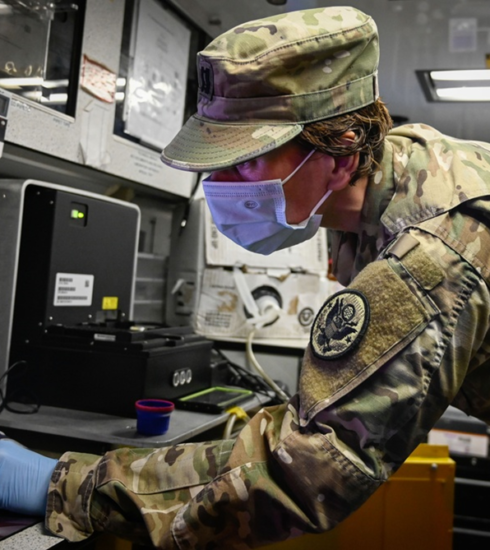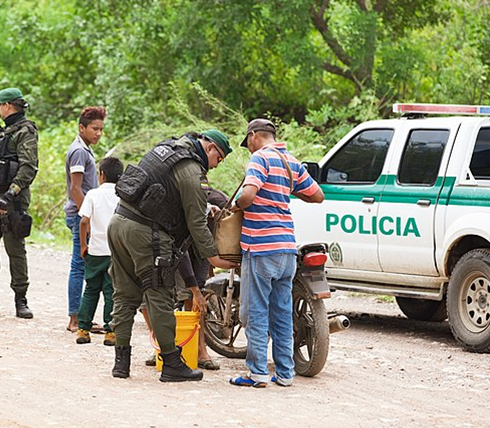The Maritime Cocaine Trade
Silver or Lead: The Maritime Cocaine Trade
I
n 2021, German port officials seized 23 tons of cocaine shipped from Panama, stashed in tins of putty and among pineapples. Authorities congratulated themselves on “this record… blow against organized narcotics crime”—but for every single billion-dollar cocaine seizure, hundreds of tons more slip through the cracks. [1] Recently, drug trafficking routes in South America have shifted south, exploiting porous borders to move cocaine from the northern cultivation regions outside the U.S.’s notice. Traffickers are now using the poor security of nontraditional ports to expand into the emerging European cocaine market. As cash flows increase and criminal organizations strengthen, the U.S. must look beyond Columbia and the Caribbean and respond to the burgeoning crisis in Europe.
Cocaine Production in South America
Even with the war on drugs raging, the cocaine market has expanded yet again. The coca plant is only found in the Andean region, particularly in Columbia, where 504,100 acres are cultivated yearly. [2] 2020 saw a record high in cocaine production, with 1,982 tons produced globally at 100% purity and distributed to 21 million users. [3] As the world’s primary cocaine consumer, the U.S. has waged a multi-decade campaign to disrupt coca cultivation, processing, and distribution, eradicating fields and combatting trafficking networks. [4] Though cartels have hardly run up the white flag, the U.S. has made progress: Columbian coca cultivation has decreased by 7.1%, [3] and port officials seize almost 500 tons of cocaine from Columbia yearly. [5]
But in targeting its nemesis—Columbia—the U.S. has permitted production to shift southwest. Keeping pace with the exploding demand, Peru and Bolivia now cultivate 14.2% more land than in 2018. [3] While they cannot produce at Columbia’s level, they have found an alternate business plan. Most Peruvian cocaine moves south through the Southern Cone region and into the emerging and extremely lucrative European market. Following little-used and counterintuitive routes, traffickers can escape detection by the ill-trained and often corrupt Southern Cone security structures. For example, the border porosity of Chile’s desolate northern edge allows traffickers to smuggle in Peruvian cocaine, which they then ship transnationally. [6] By exploiting geography, transnational criminal organizations move shipments undetected into ports unequipped and unincentivized to properly screen cargo. From South America, cocaine then flows into Europe to be distributed through other markets worldwide.
The European Cocaine Market
Over the past decade, the European cocaine trade has grown to rival that of the U.S. As traffickers flee the saturated U.S. market with its high seizure rates, they have developed new markets in Europe and Asia, where a kilo of cocaine sells for about $12,000 more than in the U.S. [7] Western European ports also act as a middleman for South American cocaine shipped to Africa, Asia, and the Middle East, strengthening trafficking routes and facilitating the distribution of other illicit commodities. [5] The receipt and distribution of Peruvian cocaine has funded organized crime across Europe, with a cash flow of billions of euros now funneling back into other criminal enterprises. [7] For example, the Italian ‘Ndrangheta mafia, who rose to power in the 1980s through the burgeoning cocaine trade, now control 80% of Europe’s cocaine flow. The ‘Ndrangheta infiltrate economic and political structures, run the world’s most profitable trafficking routes, and “colonize” territories by replicating their organizational structure throughout Europe—all ventures funded by drug money. [8]
While European port officials seized records amounts of cocaine in 2020, particularly in Belgium, this points towards increased distribution rather than the effectiveness of port controls. [5] European countries lack the counter-narcotic security structures and port controls that have proved effective in the U.S.; beyond a few police attaches, the EU has virtually no presence in Latin America and few domestic organizations dedicated to counter-narcotics. [7] Already pressured by the COVID-19 pandemic, regional instability, and the immigration crisis, the EU has failed to check the rapid growth of the cocaine trade.
The Dynamics of Nontraditional Ports
South America’s inadequate port controls are a massive point of failure in counter-narcotic efforts. While overland routes from cultivation regions to the coast remain mostly unpoliced, law enforcement has historically conserved its resources to target trafficking at choke points—in this case, seaports. In Columbia’s eastern ports along the Atlantic and Caribbean, port checks and seizure rates remain high. [9] But when this crackdown forced trafficking routes southward, traffickers began to use nontraditional, low-risk ports in countries with poor border security, such as Montevideo in Uruguay and San Antonio in Chile.
Traffickers favor maritime rather than air routes across the Atlantic, since the high rates of container flow make it impossible for port officials to screen all cargo. 750 million containers are shipped globally each day, but only 2% are inspected. [7] Smuggling techniques have evolved alongside screening technology: narcotics can be hidden within legal cargo under forged customs seals, carried in private pleasure crafts, or even concealed in the container structure. [5]
Most nontraditional ports have three key characteristics. First, they are located far from cultivation regions, making extensive land or air transportation necessary. Unlike traditional ports, which are usually close to these regions to minimize transportation costs, nontraditional ports might be found several countries away through circuitous routes. For example, Uruguay now acts as a transit country for Bolivian cocaine, with shipments passing through its unsecured border into Argentina, rather than into the larger Brazilian ports. [6]
Second, most nontraditional ports are found in countries with no reputation for drug trafficking. If a ship leaves from Argentina, Paraguay, or Chile, instead of Columbia or Costa Rica, it will trigger less of an alert in its destination port. This allows traffickers to both smuggle in drugs and disguise their origin, obfuscating the criminal network. [6] Third, traffickers favor unsecured ports with poor cargo screening procedures. Many ports which escape governmental notice are underfunded or controlled by corrupt local officials; some are even private, run by criminal syndicates. [6]
U.S. Policy Recommendations
As transnational trafficking operations expand, the current U.S. understanding of trafficking activity becomes increasingly insufficient. U.S. forces cannot focus only on the routes and regions traditionally used by traffickers, but must adapt to this new logic that utilizes counterintuitive routes and distant ports. Even current seizure rates may provide little useful information; experts warn that criminal organizations might allow drugs to be seized in some ports to distract from shipments through other ones. [6]
Neither can the U.S. funnel all its energy into propping up the border and port security of South American countries; as soon as its focus slips in the north, the narcotics trade will resurge in Columbia and the Caribbean. The U.S. intelligence community must reevaluate its understanding of how the cocaine market operates, especially on its European axis, and adapt to this shift in methods. Most importantly, the U.S. should strengthen its bilateral counter-narcotics agreements with South American and European nations, especially previously overlooked nations like Uruguay or Argentina. To identify and counter trafficking, the U.S. must work alongside existing border security structures and augment them where needed, instituting cargo screening, identifying new maritime trafficking routes, and combatting institutionalized corruption.
The U.S. should also encourage alliances between South American nations, such as the recent Brazilian-Paraguayan regional security agreement. [10] Neither should the EU be overlooked: while the EU and Latin American countries have already founded a counter-narcotics task force, the U.S. can facilitate further cooperation. [11] To secure the regions and ports currently at risk, the U.S must act quickly and decisively. It cannot secure South America’s borders alone, but any hesitation allows criminal organizations to establish and expand, spreading institutional corruption and drug violence worldwide.
[1] Cecilia Rodriguez, “New Cocaine Seizure, Worth Up To Four Billion, Breaks Record As ‘Largest Ever In Europe,’” Forbes, 25 Feb 2021, https://www.forbes.com/sites/ceciliarodriguez/2021/02/25/new-cocaine-seizure-worth-up-to-four-billion-breaks-record-as-largest-ever-in-europe/?sh=25245ad81d9d.
[2] BBC News, Colombia cocaine: UN reports record coca crop,” BBC News, 21 October 2022, https://www.bbc.com/news/world-latin-america-63339203.
[3] United Nations Office on Drugs and Crime, “World Drug Report: Drug Market Trends,” UNODC Research, June 2022, https://www.unodc.org/res/wdr2022/MS/WDR22_Booklet_4.pdf.
[4] Office of National Drug Control Policy,“Coca in the Andes,” The White House, https://obamawhitehouse.archives.gov/ondcp/targeting-cocaine-at-the-source.
[5] EMCDDA and Europol,“Europe and the Global Cocaine Trade,” European Monitoring Center for Drugs and Drug Addiction, 6 May 2022, https://www.emcdda.europa.eu/publications/eu-drug-markets/cocaine/europe-and-global-cocaine-trade_en#section1.
[6] Carolina Sampo & Valeska Troncoso, “Cocaine trafficking from non-traditional ports: examining the cases of Argentina, Chile and Uruguay,” Trends in Organized Crime, 4 January 2022, https://link.springer.com/article/10.1007/s12117-021-09441-y#Sec9.
[7] Jeremy McDermott, James Bargent, Douwe den Held, and Maria Fernanda Ramirez, “The Cocaine Pipeline to Europe,” Insight Crime, February 2021, http://fileserver.idpc.net/library/The-Cocaine-Pipeline-to-Europe-InSight-Crime-Global-Initiative.pdf.
[8] OCCRP, “What is the ‘Ndrangheta?”, Organized Crime and Corruption Reporting Project, 1 July 2021, https://www.occrp.org/en/ndrangheta/what-is-the-ndrangheta.
[9] North P&I, “Drug Smuggling in Columbian Ports,” North P&I, 4 January 2022, https://www.nepia.com/industry-news/drug-smuggling-in-colombian-ports/.
[10] Vinicius Maduriera, “Brazil and Paraguay Agree to Fight Organized Crime Together,” OCCRP, 14 April 2022, https://www.occrp.org/en/daily/16203-brazil-and-paraguay-agree-to-fight-organized-crime-together#:~:text=Over%20the%20last%20few%20years%2C%20the%20Brazilians%20and%20Paraguayans%20carried,nearly%2012%2C000%20tonnes%20of%20marijuana.
[11] EL PAcCTO, “Launch of the operational task force on combatting drug trafficking,”EL PAcCTO, 18 October 2022, https://www.elpaccto.eu/en/news/launch-of-the-task-force-on-combatting-drug-trafficking/





